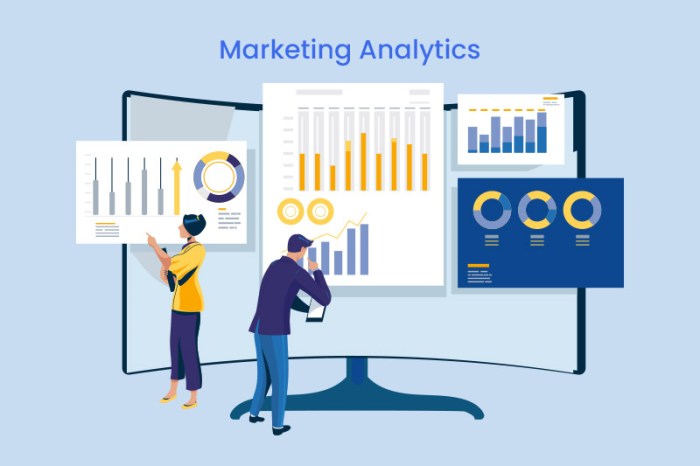Using Analytics in Marketing, dive into a world where data drives success. From measuring campaign performance to forecasting trends, analytics play a crucial role in shaping effective marketing strategies.
Understanding the different types of analytics, implementing the right tools, and analyzing key metrics can provide businesses with valuable insights to make informed decisions and optimize future campaigns.
Why Use Analytics in Marketing?

Using analytics in marketing is crucial for businesses looking to stay competitive in today’s fast-paced digital world. By analyzing data from various sources, businesses can gain valuable insights into customer behavior, preferences, and trends. This information allows companies to make informed decisions that drive their marketing strategies forward and maximize their return on investment.
Importance of Utilizing Analytics in Marketing Strategies
Analytics provide businesses with a deeper understanding of their target audience, allowing them to tailor their marketing efforts to better meet customer needs. By tracking key metrics such as website traffic, conversion rates, and customer engagement, businesses can optimize their campaigns for maximum impact. This data-driven approach ensures that marketing efforts are effective and efficient, ultimately leading to increased sales and revenue.
Benefits of Incorporating Analytics into Marketing Campaigns
– Improved Targeting: Analytics help businesses target the right audience with the right message at the right time, increasing the likelihood of conversion.
– Enhanced Personalization: By analyzing customer data, businesses can create personalized marketing campaigns that resonate with individual preferences and behaviors.
– Better ROI: With analytics, businesses can track the performance of their marketing campaigns in real-time and make adjustments to optimize their return on investment.
– Competitive Advantage: Companies that leverage analytics have a competitive edge over those that rely solely on intuition, as data-driven decisions are more likely to lead to successful outcomes.
Types of Analytics Used in Marketing: Using Analytics In Marketing
Analytics play a crucial role in helping businesses understand their customers and make informed marketing decisions. Here are some common types of analytics used in marketing:
Descriptive Analytics
Descriptive analytics involves analyzing past data to understand what has happened in the past. Businesses can leverage descriptive analytics in marketing to gain insights into customer behavior, preferences, and trends. By analyzing historical data, companies can better understand their target audience and tailor their marketing strategies accordingly.
Predictive Analytics
Predictive analytics uses data, statistical algorithms, and machine learning techniques to identify the likelihood of future outcomes based on historical data. In marketing, predictive analytics can help businesses forecast trends, predict customer behavior, and anticipate market changes. By analyzing data patterns, businesses can make data-driven decisions to optimize their marketing campaigns and maximize ROI.
Implementing Analytics Tools
Implementing analytics tools in marketing can significantly enhance a company’s ability to make data-driven decisions and improve overall performance. By utilizing popular analytics tools effectively and training marketing teams on their usage, businesses can gain valuable insights into consumer behavior, campaign performance, and ROI.
Popular Analytics Tools, Using Analytics in Marketing
- Google Analytics: A widely-used tool for tracking website traffic, user behavior, and conversion rates.
- HubSpot: Offers analytics on inbound marketing efforts, lead generation, and customer engagement.
- Adobe Analytics: Provides detailed insights into customer journeys, segmentation, and attribution modeling.
Integrating Analytics Tools into Marketing Strategy
- Define Objectives: Clearly Artikel the goals and key performance indicators (KPIs) that the analytics tools will help measure.
- Select Appropriate Tools: Choose tools that align with the specific needs of the marketing strategy and business objectives.
- Set Up Tracking: Implement tracking codes, pixels, or tags to collect relevant data from various platforms and channels.
- Analyze Data: Regularly review and analyze the data collected to identify trends, opportunities, and areas for improvement.
- Optimize Campaigns: Use insights from analytics tools to optimize marketing campaigns, targeting, and messaging for better results.
Training Marketing Teams on Analytics Tools
- Provide Hands-On Training: Offer workshops, webinars, or tutorials to teach team members how to navigate and utilize analytics tools effectively.
- Focus on Data Interpretation: Emphasize the importance of interpreting data accurately and drawing actionable insights from analytics reports.
- Encourage Collaboration: Foster a culture of collaboration and knowledge-sharing among team members to leverage the full potential of analytics tools.
- Continual Learning: Encourage ongoing learning and skill development in data analysis and interpretation to keep up with evolving trends and technologies.
Analyzing Marketing Campaign Performance

When it comes to evaluating the success of marketing campaigns, analytics plays a crucial role in providing insights and data-driven decisions. By analyzing the performance of campaigns, businesses can understand what strategies are working and where adjustments need to be made.
Key Metrics and KPIs for Marketing Performance
Measuring marketing campaign performance involves tracking various key metrics and KPIs that provide valuable information on how well a campaign is performing. Some of the key metrics and KPIs include:
- Conversion Rate: The percentage of users who take a desired action, such as making a purchase or signing up for a newsletter.
- Click-Through Rate (CTR): The percentage of people who click on a specific link in an email, ad, or webpage.
- Return on Investment (ROI): The ratio of how much revenue a campaign generated compared to the cost of running the campaign.
- Cost per Acquisition (CPA): The cost of acquiring a new customer through a specific campaign.
Optimizing Future Campaigns with Analytics Data
By leveraging data from analytics tools, businesses can optimize future marketing campaigns for better results. Some ways data can be used include:
- Identifying High-Performing Channels: Analyzing which channels drive the most conversions can help allocate resources effectively.
- A/B Testing: Testing different elements of a campaign to see which variations perform better and making data-driven decisions for future campaigns.
- Customer Segmentation: Using data to segment customers based on behavior and preferences to deliver personalized campaigns that resonate with the target audience.
